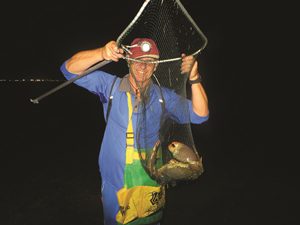
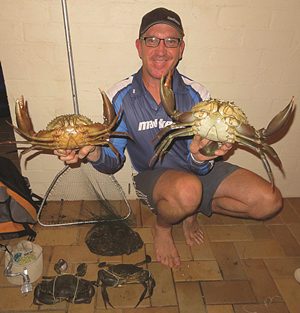
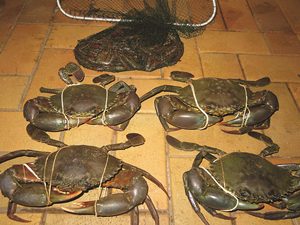
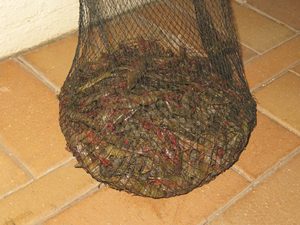
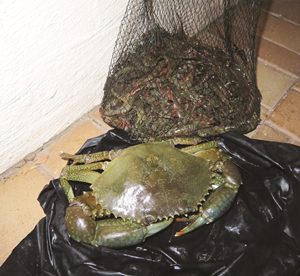
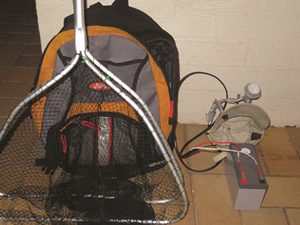
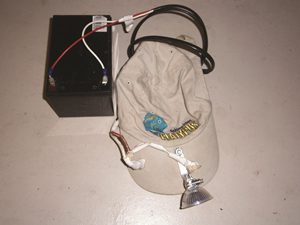
IT is that time again – time to hunt prawns and mud crabs.
Nothing new about that over summertime, but this is prawning and crabbing with a difference – from the shore in Brisbane’s Moreton Bay. For our NSW readers, you would be familiar with the favourite summer pastime of chasing greasyback, eastern king and tiger prawns in the estuaries. This typically involves waiting for the prawns to ‘run’ towards the entrance of the estuaries (whether they are open or closed) on a new moon night. They are caught with a prawn scoop net and spotted using an underwater prawning light attached to a battery either carried on a floating tube or via a small motorcycle battery in a backpack.
Likewise, readers from the north would be familiar with the summer practice of being able to cast net banana prawns schooled in the shallow surf areas and estuaries in mid to late summer. However, my style of Moreton Bay land-based prawning is very different. Rather than waiting for the prawns to come to you in waist-deep water, these bay and tiger prawns are much more dispersed and less active.
These prawns are best chased at low tide at night on the Moreton Bay flats, particularly those flats with patches of seagrass and sandy or muddy bottoms. These prawns are in water between ankle and thigh deep. On high tide, the water is too deep and the prawns too dispersed, especially around bayside locations where the high tide comes right up to the rock walls.
Prawn locations
While I only prawn in my local Wynnum North to Lota area, I can’t see why any of the shallow sand/mud flats with weed interspersed wouldn’t be worth a try from Victoria Point to Wynnum North. It may be productive to try further north and south too.
Be mobile
As prawns in the Moreton Bay shallows are usually found in patches, sometimes this means wading several-hundred metres in shallow water in one night to find concentrations of them. As a result, underwater lights, designed for lighting up prawns in a relatively close proximity in deeper water, are largely ineffective. When prawning the shallows, you are scanning in the dark looking for the tell-tale sign of bright red beady eyes, and the bigger, the better!
Powerful headlamps are the best option to aid this search. Occasionally, you strike it lucky and the bottom is lit up like a Christmas tree, but this is more the exception than the rule. For the sort of light you need on the water, I have found commercial headlamps largely unproductive and so use a DIY headlamp built into a cap and connected to a 12V battery. To make your own headlamp, all you need is an old cap and a few bits and pieces from a store such as Jaycar Electronics.
See the attached picture and fact box on what you’ll need to make your own. These headlamps are run from 12V 9A batteries I carry around in a small backpack, along with a screwdriver and light battery-operated headlamp for any running repairs. Basically, you just want to screw a hole in the peak of your cap and attach the bendable bar to it with the screw.
The bar should be fitted in an L shape to the cap tip so you can clamp the bi-pin lamp connector (connected to the cable) to your LED lamp. You also screw another hole in the cap peak to attach the on/off switch that also connects to the electrical wire. The other end of the wire is fitted with the battery terminal clips. The snap-lock ties are to keep it all tidy.
Other pieces of necessary equipment are two prawn scoop nets (available from tackle shops), thick-soled shoes and a soft Esky or shoulder bag to carry your prawns in. Waders are not necessary in summertime and in fact the heavy soles from waders tend to stir the muddy bottom up, making it hard to see the prawns. An Alvey Dry Pack is a handy addition to carry any keys, phone and so on zipped up and secure in your backpack in case you need to place your backpack on the wet ground when changing batteries at any stage.
Catching prawns
The trick with this method of prawning is using two prawn nets to maximise your success rate. I have checked with both Fisheries Queensland and Parks and Wildlife (responsible for the Moreton Bay Marine park), who confirmed it is legal to use two scoop nets. The nets just need to be in your control, not staked, and their size must conform to the current regulations.
Once you have spotted the prawn, you want to get your nets in position to give you the best chance of capturing it. For prawns sitting on the bottom, the most successful technique is to place your nets at a 90-degree angle to the prawn. In other words, place the nets side on to the prawn’s body. The trick is to make sure you get close to the prawn and bring the nets together on the bottom quickly and you will catch it in either net.
Given the length of the scoop net, you can then carry around a few caught prawns in the bottom of the net until you transfer them to your cooler bag or Esky on your shoulder.
Timing
Best prawning times are from late-November to the end of March in Moreton Bay. The key factors for a successful night are a hot day and calm night so the water is not disturbed by wind chop. The less wind chop on the water, the clearer the water and the further away you can spot them. You want to be looking for wind of less than 15 knots, but ideally less than 10 knots for clearer water and less ripples.
Before you head out, check the Fish Ranger app for the latest localised ‘on the water’ wind readings. I choose Fish Ranger over many of the other popular forecasts because it has on the water forecasts from the Bureau of Meteorology and the latest US GIS model as opposed to land-based forecasts of the other models.
The other great thing about prawning the Moreton Bay shallows is it is not moon-dependent. The prawns will be there regardless of a full or new moon. The best time of tide is from about two hours before low to two hours after low. This means, based on the rule of twelfths for tides, you would be prawning in a maximum of 2/12 or 1/6 of the tide’s height.
At this time the prawns are in the shallows and easily accessible. See the tide rule of twelfths attached.
Muddies on foot
A huge bonus when wading the flats for prawns over summer is coming across a mud crab either sitting outside its rocky or muddy burrow or walking along the flats looking for food. You will be surprised by how many you see. To catch the crab, again you can use one net to spook it into the other net. Another option is to place the butt of the net on top of the crab and measure it or pick it up by the flippers with your hands, but I don’t recommend this to anyone not experienced in crab handling.
Once you’ve established it’s a buck, use your crab measure to ensure it is at least 15cm from point to point (in Queensland). Likewise, check the crab has plenty of meat and is not empty. You can look for a few things.
Don’t take a crab that has:
- An army green-coloured, clean shell (that is, free of growth or barnacles) and sharp ‘teeth’ on the claws.
- Any movement when you gently press the top of the shell.
- Any movement when you press the underside next to the second leg on either side of the body.
Another place to search for crabs is the entrance to their rocky burrows. If you are lucky, you will spot one outside its burrow, and if quick enough with a net behind it, you can scoop it and measure it!
A word of warning
It is important to add a few words of caution. Prawning at night on foot in Moreton Bay is not for everyone. You need to trudge across over 100m of boggy mud flats and sink to your shins to get there in many places.
It is also very dark and you see and hear a lot of things and get a few bumps into your legs and splashes behind you in the dark. You will see stingrays, crabs and a range of other species. Thick-soled reef shoes are a must for protection.
While I have only ever spotted two small sharks in the shallows where I prawn in over 10 years, I have no intention to chase prawns any deeper than thigh level to find out if more are out there. While you may not catch as many prawns as cast netting banana prawns in a boat, I prefer this style of prawning for a number of reasons. It is a greater challenge, you are under the stars and away from the crowds and you can catch the odd mud crab or three as a bonus. The kids also love it and it is great exercise!
For more tips, advice and giveaways, check out my Ontour Fishing Australia Facebook and Instagram pages.
Until next month – bag your mates, not your limit!
DIY HEADLAMP – WHAT YOU’LL NEED
- Cap
- 7W LED headlamp
- Bi-pin lamp connector
- 20mm screw and nut
- Screw-in clamp
- Switch
- 80mm L x 10mm W metal bar (bendable)
- 2m of split electrical cable
- 2 battery terminal clips
- Snap-lock ties
- Electrical tape
| Tides and the rule of twelfths | |
| The amount of tide movement in each hour of the tide after high or low | |
| 1st hour | 1/12 |
| 2nd hour | 2/12 |
| 3rd hour | 3/12 |
| 4th hour | 3/12 |
| 5th hour | 2/12 |
| 6th hour | 1/12 |
 Bush ‘n Beach Fishing Magazine Location reports & tips for fishing, boating, camping, kayaking, 4WDing in Queensland and Northern NSW
Bush ‘n Beach Fishing Magazine Location reports & tips for fishing, boating, camping, kayaking, 4WDing in Queensland and Northern NSW










Interested in small scale commercial prawn fishing, orokolo bay gulf of papua PNG.